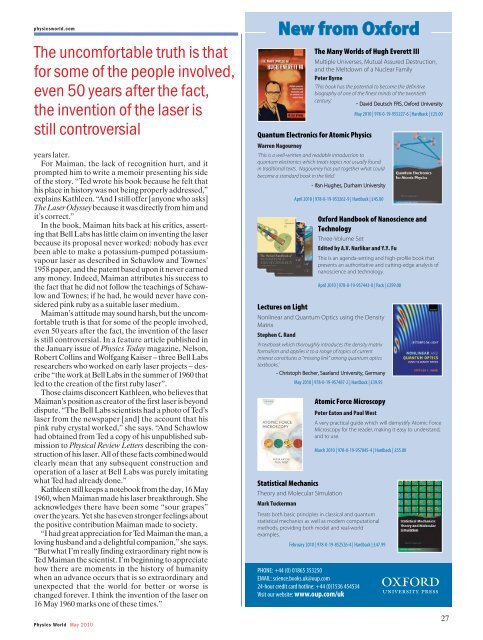special issue
special issue
special issue
You also want an ePaper? Increase the reach of your titles
YUMPU automatically turns print PDFs into web optimized ePapers that Google loves.
physicsworld.comThe uncomfortable truth is thatfor some of the people involved,even 50 years after the fact,the invention of the laser isstill controversialyears later.For Maiman, the lack of recognition hurt, and itprompted him to write a memoir presenting his sideof the story. “Ted wrote his book because he felt thathis place in history was not being properly addressed,”explains Kathleen. “And I still offer [anyone who asks]The Laser Odyssey because it was directly from him andit’s correct.”In the book, Maiman hits back at his critics, assertingthat Bell Labs has little claim on inventing the laserbecause its proposal never worked: no body has everbeen able to make a potassium-pumped potassiumvapourlaser as described in Schawlow and Townes’1958 paper, and the patent based upon it never earnedany money. Indeed, Maiman attributes his success tothe fact that he did not follow the teachings of Schaw -low and Townes; if he had, he would never have consideredpink ruby as a suitable laser medium.Maiman’s attitude may sound harsh, but the uncomfortabletruth is that for some of the people involved,even 50 years after the fact, the invention of the laseris still controversial. In a feature article published inthe January <strong>issue</strong> of Physics Today magazine, Nelson,Ro bert Collins and Wolfgang Kaiser – three Bell Labsresearchers who worked on early laser projects – des -cribe “the work at Bell Labs in the summer of 1960 thatled to the creation of the first ruby laser”.Those claims disconcert Kathleen, who believes thatMaiman’s position as creator of the first laser is beyonddispute. “The Bell Labs scientists had a photo of Ted’slaser from the newspaper [and] the account that hispink ruby crystal worked,” she says. “And Schawlowhad obtained from Ted a copy of his unpublished submissionto Physical Review Letters describing the constructionof his laser. All of these facts combined wouldclearly mean that any subsequent construction andoperation of a laser at Bell Labs was purely imitatingwhat Ted had already done.”Kathleen still keeps a notebook from the day, 16 May1960, when Maiman made his laser breakthrough. Sheacknowledges there have been some “sour grapes”over the years. Yet she has even stronger feelings aboutthe positive contribution Maiman made to society.“I had great appreciation for Ted Maiman the man, aloving husband and a delightful companion,” she says.“But what I’m really finding extraordinary right now isTed Maiman the scientist. I’m beginning to appreciatehow there are moments in the history of humanitywhen an advance occurs that is so extraordinary andun expected that the world for better or worse ischanged forever. I think the invention of the laser on16 May 1960 marks one of these times.”Physics World May 2010New from OxfordThe Many Worlds of Hugh Everett IIIMultiple Universes, Mutual Assured Destruction,and the Meltdown of a Nuclear FamilyPeter ByrneQuantum Electronics for Atomic PhysicsWarren Nagourney‘This is a well-written and readable introduction toquantum electronics which treats topics not usually foundin traditional texts. Nagourney has put together what couldbecome a standard book in the field.’- Ifan Hughes, Durham UniversityOxford Handbook of Nanoscience andTechnologyThree-Volume SetLectures on LightNonlinear and Quantum Optics using the DensityMatrixStatistical MechanicsTheory and Molecular SimulationEdited by A.V. Narlikar and Y.Y. FuThis is an agenda-setting and high-profile book thatpresents an authoritative and cutting-edge analysis ofnanoscience and technology.Stephen C. Rand‘A textbook which thoroughly introduces the density matrixformalism and applies it to a range of topics of currentinterest constitutes a "missing link" among quantum opticstextbooks.’- Christoph Becher, Saarland University, GermanyMay 2010 | 978-0-19-957487-2 | Hardback | £39.95Mark Tuckerman‘This book has the potential to become the definitivebiography of one of the finest minds of the twentiethcentury.’- David Deutsch FRS, Oxford UniversityMay 2010 | 978-0-19-955227-6 | Hardback | £25.00April 2010 | 978-0-19-953262-9 | Hardback | £45.00April 2010 | 978-0-19-957443-8 | Pack | £299.00Atomic Force MicroscopyPeter Eaton and Paul WestA very practical guide which will demystify Atomic ForceMicroscopy for the reader, making it easy to understand,and to use.March 2010 | 978-0-19-957045-4 | Hardback | £55.00Treats both basic principles in classical and quantumstatistical mechanics as well as modern computationalmethods, providing both model and real-worldexamples.February 2010 | 978-0-19-852526-4 | Hardback | £47.99PHONE: +44 (0) 01865 353250EMAIL: science.books.uk@oup.com24-hour credit card hotline: +44 (0)1536 454534Visit our website: www.oup.com/uk127



